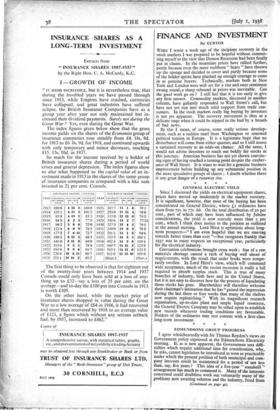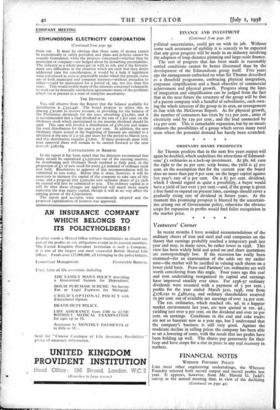FINANCE AND INVESTMENT
By CUSTOS WHEN I wrote a week ago of the incipient recovery in the stock markets I was prepared to be hopeful without commit- ting myself to the view that Demon Recession had been finally put in chains. In the meantime prices have rallied further, partly because even the more stubborn " bears " have thrown up the sponge and decided to cover and partly because some of the bolder spirits have plucked up enough courage to come in as genuine buyers. Technically, markets both in New York and London were well set for a rise and once sentiment swung round, a sharp rebound in prices was inevitable. Can the good work go on ? I still feel that it is too early to give any firm answer. Commodity markets, discussed in another column, have gallantly responded to Wall Street's call, but have not yet run into much solid support from trade con- sumers. In the stock markets really big buying by investors is not yet apparent. The recovery movement is thus at a delicate stage when it could be nipped in the bud by a breath of bad news.
By this I mean, of course, some really serious develop- ment, such as a sudden snarl from Washington or renewed political tension in Europe. It is a legitimate hope that no disturbance will come from either quarter, and so I still assess a sustained recovery as an odds-on chance. All the same, I would not advise investors to reach out boldly for stocks at this juncture. American business has not yet shown convinc- ing signs of having reached a turning point despite the exuber- ance of Wall Street. It is wiser to wait fora genuine business improvement before building up any substantial position in the more speculative groups of shares ; I doubt whether there is any great danger of a runaway rise.
* * * *
GENERAL ELECTRIC YIELD
Since I discussed the yields on electrical equipment shares, prices have moved up moderately in the market recovery. It is significant, however, that most of the buying has been concentrated on General Electric, whose Li ordinaries have risen from 72s. to 77s. 6d. On the total distribution of 20 per cent., part of which may have been influenced by Jubilee considerations, the yield is now scarcely more than 5 per cent., which I think does justice to the position as outlined at the annual meeting. Lord Hirst is optimistic about long- term prospects—" I am even hopeful that we are steering towards better times than ever "—but recognises frankly that 1937 was in many respects an exceptional year, particularly for the electrical industry.
Coronation celebrations brought extra work ; fear of a raw materials shortage caused a rush of buying well ahead of requirements, with the result that order books were tempo- rarily swollen. In Lord Hirst's view, which wal command wide acceptance, much of the recent recession is really a lull required to absorb surplus stock. This is true of many branches of industry, both here and in the United States, but it is not easy to discover how far the process of liquidating those stocks has gone. Shareholders will therefore welcome their chairman's intimation that he has CC gained the impression during the last three or four weeks that many of the shelves now require replenishing." With its magnificent research organisation, up-to-date plant and ample liquid resources, the General Electric Company may be relied upon to establish new recordi whenever trading conditions are favourable. Holders of the ordinaries may rest content with a first-class long-term investment. * * * *
EDMUNDSONS GROUP PROGRESS
I agree wholeheartedly with Sir Thomas Royden's views on Government policy expressed at the Edmundsons Electricity meeting. If, as is now apparent, the Government sees diffi- culties which require additional time for consideration, why, he asks, cannot legislation be introduced as soon as practicable under which the present position of both municipal and com- pany interests could be maintained for a period of not less than, say, five years ? This idea of a five-year " standstill " arrangement has much to commend it. Many of the interests concerned could doubtless work out voluntarily many of the problems now awaiting solution and the industry, freed from
(Continued on page 40)
FINANCE AND INVESTMENT
• (Continued from page 38)
political uncertainties, could get on with its job. Without some such assurance of stability it is scarcely to be expected that any great progress will be made in an industry involving the adoption of long-distance planning and large-scale finance. The sort of progreis that has been made in reasonably settled conditions cannot be better illustrated than by the development of the Edmundsons group itself. Five years ago the management embarked on what Sir Thomas described as a threefold programme, embracing physical integration, corporate simplification and a fixed objective of commercial achievement and physical growth. Progress along the lines of integration and simplification can be judged from the fact that in the near future the structure of the group will be that of a parent company with a handful of subsidiaries, each own- ing the whole interests of the group in its area, an arrangement in line with the McGowan Report. As for physical growth, the number of consumers has risen by 115 per cent., units of electricity Sold by 129 per cent., and the load connected by 14 per cent. This is remarkable expansion, but by no means exhausts the possibilities of a group which serves many rural areas where the potential demand has barely been scratched.
* * * *
ORDINARY SHARE PROSPECTS
Sir Thomas predicts that in the next five years output will again be doubled, which underlines the attractions of Edmund- sons' Li ordinaries as a lock-up investment. At 38s. 6d. cum the right to the 5o per cent. scrip bonus, the yield is 42 per cent. on the assumption that for the current year the board does no more than pay 6 per cent. on the larger capital against last year's rate of 9 per cent. On a 6i per cent. dividend, which I should regard as quite a possibility, a buyer would have a yield of just over 5 per cent.—and, if the group is given a free hand to expand on present lines, earnings should cover a gradually rising rate of dividend in future years. At the moment this promising prospect is blurred by the uncertain- ties arising out of Government policy, otherwise the obvious scope for expansion in profits would find fuller recognition in the market price. - * * - * Venturers' Corner In recent months I 'have avoided recommendations of the ordinary shares of iron and steel and coal companies on the theory that earnings probably reached a temporary peak last year and may, in many cases, be rather lower in 1938. This view has been widely held and acted on and share quotations are correspondingly low. If the recession has really been stemmed—for an examination of the odds see my earlier note—the market will be justified in valuing such shares on a lower yield basis. Pease and Partners' los. ordinaries are Well worth considering from this angle. Four years ago this coal and iron undertaking reorganised its capital and earnings have improved steadily ever since. For 1936-37 ordinary dividends were resumed with a payment of 5 per vent. ; profits for the year ended March 31st, 1938, rose from £278,192 to £480,054, and ordinary shareholders received xo per cent. out of available net earnings of over 24 per cent. The xos. ordinaries, which reached 16s. 9d. in a happier market environment last year, are now quoted at xos. 9d., yielding just over 9 per cent. on the dividend and over 20 per cent. on earnings. Conditions in the coal and coke trades are not so buoyant now as a year ago, but I understand that the company's business is still very good. Against the moderate decline in selling prices the company has been able to set a lowering of costs, with the result that net profits have been holding up well. The shares pay generously for their keep and have scope for a rise in price in any real recovery in markets.
*



















































 Previous page
Previous page